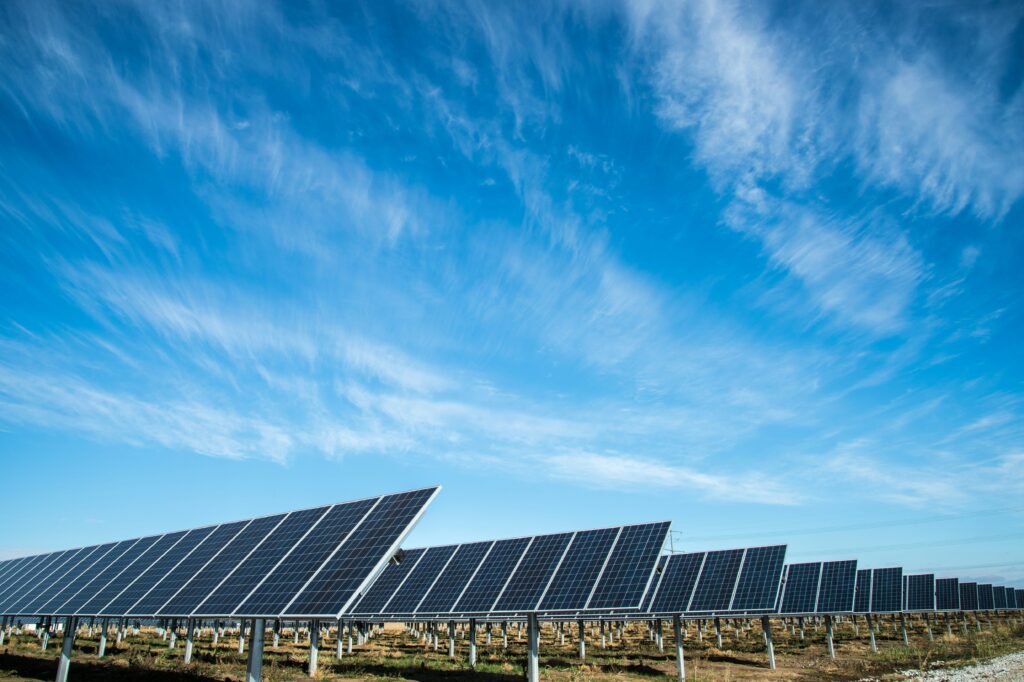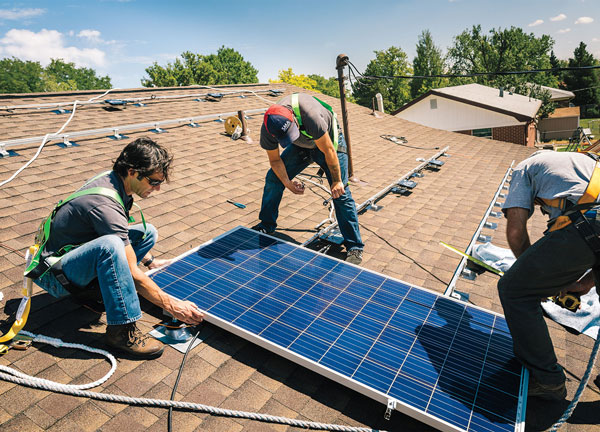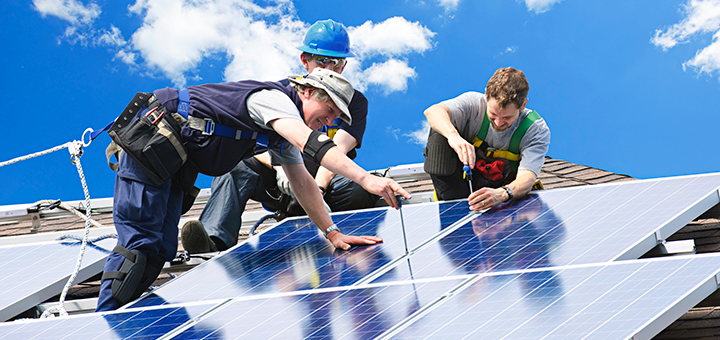The best way to install solar panels is to hire a professional installer who will assess your property, determine the optimal placement, and handle the installation process for you. Installing solar panels on your own can be risky and may not yield optimal results.

Solar panel installation requires expertise, knowledge of electrical systems, and familiarity with building codes and regulations. Therefore, it’s recommended to work with experienced professionals to ensure a proper and efficient installation that maximizes the benefits of solar energy. By hiring professionals, you can have peace of mind knowing that your solar panels are installed correctly and will provide you with clean, renewable energy for years to come.

Credit: www.hachettebookgroup.com
Benefits Of Installing Solar Panels
Installing solar panels offers numerous benefits that make it an excellent investment in both economical and environmental terms. From dramatically reducing electricity bills to contributing to environmental sustainability, solar panel installations are an effective way to harness renewable energy and embrace a greener lifestyle.
Reduced Electricity Bills
Solar panels enable homeowners and businesses to significantly reduce their electricity bills. By harnessing energy from the sun, solar panels generate free power to use for lighting, heating, and operating household and commercial appliances. This helps people cut down on their energy expenses while also promoting self-sufficiency and independence from traditional energy providers.
Environmental Sustainability
Embracing solar power contributes to environmental sustainability through a significant reduction in carbon emissions and reliance on non-renewable energy sources. Solar energy is a clean and renewable resource that leads to a reduced carbon footprint, helping combat climate change and preserve the environment for future generations.
Assessing The Feasibility
Before you start the installation of solar panels, it is crucial to assess the feasibility of your solar project. This involves determining the solar potential of your location and evaluating the sunlight exposure available. By thoroughly understanding these factors, you can optimize the installation process and maximize the benefits of solar energy.
Determine Solar Potential
Assessing the solar potential of your location is the first step towards successful solar panel installation. You need to determine how suitable your area is for harnessing solar energy. Factors such as the amount of sunlight your location receives, the climate, and the angle and orientation of your roof play a significant role in making this assessment.
Here’s how you can determine the solar potential:
- Consult Solar Maps: Utilize solar maps to understand the solar potential of your region. These maps provide valuable information about the average amount of sunlight your location receives throughout the year.
- Evaluate Solar Path: Observe the path of the sun throughout the day to identify any potential obstructions that may cast a shadow on your solar panels.
- Consider Roof Orientation: Assess the orientation and tilt of your roof. South-facing roofs usually receive the most sunlight, making them ideal for solar panel installation.
Evaluate Sunlight Exposure
Once you have determined the solar potential of your location, the next step is to evaluate the sunlight exposure available for your solar panels. Seamless exposure to sunlight is essential for optimum energy generation. Here are the key factors to consider during evaluation:
- Shade Analysis: Identify any objects or structures, such as trees or adjacent buildings, that may cast shadows on your solar panels. Avoid areas with prolonged shade as it can reduce the efficiency of your system.
- Time of Day: Observe the movement of the sun throughout the day and determine which areas of your property receive the most sunlight. Install your solar panels in these well-exposed areas.
- Seasonal Changes: Consider the impact of seasonal changes on sunlight exposure. While it’s challenging to predict the exact angles and intensity of the sun throughout the year, understanding the general trends can help you optimize panel placement.
By meticulously assessing the feasibility of installing solar panels, you set the stage for a successful and efficient solar energy system. Take the time to determine the solar potential and evaluate sunlight exposure, ensuring your installation brings you the maximum benefits of renewable energy.
Selecting The Right Solar Panel System
When it comes to installing solar panels, selecting the right system is crucial. Your choice will impact the efficiency, cost, and overall performance of your solar panel installation. Here are some important factors you need to consider when selecting the right solar panel system.
Consider Energy Needs
Before installing solar panels, it’s important to evaluate your energy needs. Calculate the amount of electricity you consume on a monthly basis. This will help you determine the size of the solar system necessary to meet your energy requirements. Keep in mind that the system should be able to generate enough electricity to cover your usage even during times of high demand.
Choose Between On-grid And Off-grid Systems
Another crucial decision to make is whether to opt for an on-grid or off-grid solar panel system. On-grid systems are connected to the utility grid, allowing you to sell excess energy back to the grid and receive credits. These systems are ideal if you live in an area with a reliable electricity supply. On the other hand, off-grid systems function independently and require energy storage solutions, such as batteries, to ensure a continuous power supply. Off-grid systems are suitable for remote locations or areas prone to power outages.
Research Different Types Of Solar Panels
Not all solar panels are created equal. Researching the different types of solar panels available will enable you to make an informed decision. Some popular options include monocrystalline, polycrystalline, and thin-film solar panels. Monocrystalline panels are known for their high efficiency and sleek appearance, while polycrystalline panels are more cost-effective. Thin-film panels, on the other hand, are lightweight and flexible, making them suitable for certain installation situations. Consider the pros and cons of each type, as well as their compatibility with your energy needs and budget.
In conclusion, selecting the right solar panel system requires careful consideration of your energy needs, the choice between on-grid or off-grid systems, and the research of different panel types. By taking the time to evaluate these factors, you can ensure that your solar panel installation is optimized for efficiency, cost-effectiveness, and long-term performance.
Finding A Reliable Solar Panel Installer
Solar panels are a long-term investment in clean energy for your home. However, the success of your solar panel installation greatly depends on finding a reliable and experienced solar panel installer. Choosing the right installer who understands your needs and provides top-quality service is crucial. Here are some essential steps to help you find a reliable solar panel installer:
Read Online Reviews
Before selecting a solar panel installer, it is essential to conduct detailed research. A valuable way to gather information about a potential installer is by reading online reviews. Look for reviews that praise the installer’s customer service, installation expertise, and overall satisfaction. Keep in mind that a few negative reviews are common, but pay attention to recurring trends or serious issues mentioned by multiple customers.
Get Multiple Quotes
Requesting multiple quotes from different solar panel installers can provide you with an idea of the average cost and services offered in your area. By comparing quotes, you can ensure that you are receiving a fair price for the installation services. It also allows you to evaluate the level of professionalism and responsiveness of each installer, helping you make an informed decision.
Check Credentials And Certifications
Verifying the credentials and certifications of a solar panel installer is crucial to ensure that they are qualified and experienced in the field. Look for certifications such as NABCEP (North American Board of Certified Energy Practitioners) and licenses from relevant authorities, ensuring they comply with industry standards and regulations. Additionally, inquire about the installer’s experience and ask for references to validate their track record.
Preparing Your Home For Solar Panel Installation
Preparing your home for solar panel installation is crucial to ensure the best way to install solar panels. By following the necessary steps, you can optimize your system’s performance and maximize energy savings for years to come.
Preparing your home for solar panel installation is an important step in harnessing the power of the sun to generate electricity. Before you can start enjoying the benefits of solar energy, there are a few key considerations to keep in mind. This section will guide you through the process, providing valuable information on how to assess your roof condition, ensure adequate roof space, and check electrical system compatibility.
Assess Roof Condition
Before installing solar panels, it’s crucial to assess the condition of your roof to determine if it can support the weight and withstand the installation process. Here’s a step-by-step guide to assess your roof condition:
1. Start by visually inspecting your roof for any signs of damage or deterioration, such as cracked tiles, loose shingles, or sagging areas. If you notice any issues, it’s important to have them repaired before proceeding with solar panel installation.
2. Check the age of your roof. Typically, solar panels have a lifespan of 25-30 years, so it’s essential to ensure that your roof is in good condition and has a similar lifespan. If your roof is nearing the end of its life, it might be wise to consider replacing it before installing solar panels.
3. Determine the roof’s orientation and tilt angle. Solar panels generate the most electricity when exposed to maximum sunlight. Ideally, your roof should face south or have a slight tilt towards the south to optimize sunlight exposure.
Ensure Adequate Roof Space
Having sufficient roof space is another crucial factor to consider when installing solar panels. Here’s how to ensure you have enough space:
1. Measure the available roof area where you plan to install solar panels. Keep in mind that shading from nearby trees, buildings, or obstructions can affect the performance of your solar panels. Therefore, it’s vital to choose a location on your roof that receives ample sunlight throughout the day.
2. Consider the size and number of solar panels you intend to install. The space required will depend on your energy needs and the efficiency of the solar panels. A solar installation professional can help you determine the optimal number of panels based on your energy consumption.
3. Calculate the minimum spacing required between panels to allow for proper ventilation and prevent shading between them. This will ensure that all panels operate optimally and maximize your solar energy production.
Check Electrical System Compatibility
Before connecting your solar panels to the electrical grid, it’s essential to ensure that your existing electrical system is compatible. Follow these steps to check compatibility:
1. Consult a licensed electrician to evaluate your electrical system’s capacity and determine if any upgrades are necessary to accommodate the solar panels. This assessment will help you avoid overloading your system and ensure a seamless integration.
2. Confirm that your electrical panel can accommodate additional circuit breakers to connect the solar panels. If your panel is outdated or lacks space for additional breakers, you may need to consider upgrading the panel to meet the requirements.
3. Ensure that your electrical system meets all local regulations and safety standards. A qualified electrician can help you navigate these requirements and obtain any necessary permits for the installation.
By carefully assessing your roof condition, ensuring adequate roof space, and checking electrical system compatibility, you’ll be well-prepared to install solar panels and embrace the many environmental and financial benefits they offer.

Credit: www.electricchoice.com
The Installation Process
Learn the best method for installing solar panels in a simple and efficient process that maximizes energy production. This step-by-step guide provides valuable insights for a successful installation.
Site Survey And Design
Before installing solar panels, the first step is conducting a site survey and designing the system accordingly. This crucial stage ensures optimal performance and efficiency of your solar panel installation.
In a site survey, a technician visits your property to assess its suitability for solar panel installation. They evaluate various factors like roof size, orientation, shading, and structural integrity. This information helps in determining the best placement and layout of your solar panels.
Additionally, during the site survey, the technician measures your electricity usage, ensuring the solar panel system is designed to meet your specific energy needs. This customized design ensures maximum energy production and cost savings.
Panel Mounting And Wiring
Once the site survey and design stage is completed, the actual installation process begins with panel mounting and wiring. This phase involves the physical installation of the solar panels on your roof or ground-mounted framework.
The solar panels are carefully mounted using secure and reliable racking systems, ensuring their stability and durability. The position and angle of the panels are set to optimize exposure to sunlight throughout the day, maximizing energy generation.
After mounting the panels, the wiring process ensures proper electrical connections. This involves connecting the solar panels in series or parallel configurations, depending on the system design. The wiring is done with precision to minimize energy losses and maximize the system’s overall performance.
Connecting To The Electrical Grid
Connecting your solar panel system to the electrical grid is the final step of the installation process. This allows you to benefit from net metering, where excess electricity generated by your panels can be fed back into the grid for credits.
To connect to the grid, an inverter is installed. The inverter converts the direct current (DC) produced by the solar panels into alternating current (AC), which is used by household appliances and can be fed into the grid.
At this stage, the system undergoes rigorous testing and inspection to ensure compliance with local regulations and safety standards. Once approved, your solar panel system is officially connected to the electrical grid, and you can start enjoying clean, renewable energy.
In conclusion, the installation process of solar panels involves a detailed site survey and design to optimize performance, followed by panel mounting and wiring to physically install the panels, and finally connecting to the electrical grid for seamless integration into your home’s power supply.
Maintaining And Monitoring Your Solar Panel System
Looking for the best way to install solar panels? Maintaining and monitoring your solar panel system is crucial for optimal performance. Regular inspections and cleaning, along with professional maintenance, ensure maximum energy production from your solar panels.
Maintaining and Monitoring Your Solar Panel System
Regular Cleaning and Inspection
To ensure optimal energy production, it’s essential to regularly clean and inspect your solar panel system. Dirt and debris can accumulate on the panels, reducing their efficiency. A simple quarterly cleaning routine using a mild detergent and water is sufficient to keep your panels in top condition. Additionally, inspect for any cracks, corrosion, or loose connections to address potential issues before they escalate.
Monitoring Energy Production
Constantly monitoring the energy production of your solar panel system allows you to identify any discrepancies or performance issues promptly. Utilize the monitoring equipment that comes with your system or invest in additional monitoring software to accurately track your energy output. This can help in identifying any decline in efficiency and allow for timely intervention.
Addressing Technical Issues
In the event of technical issues, it’s crucial to address them promptly to minimize downtime and maintain the system’s effectiveness. If you notice any significant decline in energy production, it’s advisable to contact your solar panel provider or a qualified technician. Addressing technical issues in a timely manner ensures the smooth functioning of your solar panel system.
By following these practices and staying proactive with maintenance and monitoring, you can ensure the longevity and efficiency of your solar panel system.

Credit: roofingmagazine.com
Frequently Asked Questions On Best Way To Install Solar Panels
How Much Does It Cost To Install Solar Panels?
The cost to install solar panels varies depending on factors such as the size of the system, location, and any additional equipment needed. On average, homeowners can expect to spend between $15,000 and $30,000 for a complete installation.
How Long Does It Take To Install Solar Panels?
The installation of solar panels typically takes about one to three days, depending on the size of the system and complexity of the project. However, it’s important to note that certain factors, such as weather conditions and permit approvals, can affect the timeline.
What Are The Benefits Of Installing Solar Panels?
Installing solar panels offers numerous benefits, including reduced electricity bills, decreased dependence on fossil fuels, and a positive impact on the environment. Additionally, solar panels can increase the value of your home and provide a reliable source of renewable energy for years to come.
Conclusion
Installing solar panels can be an efficient and sustainable way to power your home. By following the right steps and seeking professional help, you can maximize the benefits of solar energy. As a source of clean and renewable power, solar panels offer a long-term solution for reducing your carbon footprint and saving on energy costs.